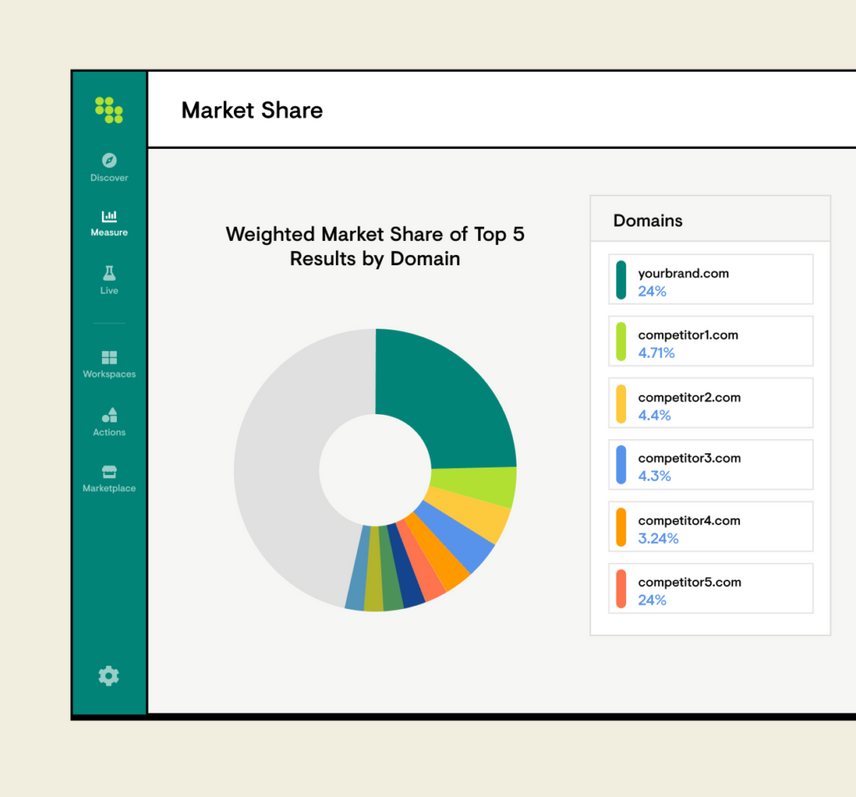Top Takeaways from the Latest Google Core Algorithm Update: May 2022
- Industry News
- By multiple authors
- 7 minutes read
The Google May 2022 core algorithm update has fully rolled out. Find out what’s new, how it impacts your site and search visibility, and what you can do about it with supporting Conductor workflows.
It’s that time of year again: Google’s latest core update launched on May 25 and has fully rolled out. By now, you are likely seeing changes in traffic, rankings, and featured result type winners—to name a few. The SEO experts at Conductor have you covered with all the details on what the May 2022 broad core algorithm update included and what it means for your SEO strategy, along with tips and Conductor-specific workflows to help you navigate the latest changes.
A quick refresher on Google core updates
Before we dive into the details, here’s a recap on key things to note with Google’s core updates:
- Google makes substantial improvements to overall ranking processes several times each year, which are referred to as core updates .
- Core updates are designed to increase the overall relevancy of search results and make them more helpful and useful for everyone.
- The latest core update was released on May 25, 2022, and took about 1-2 weeks to roll out fully.
- If you saw traffic drops around late June or early July don’t stress. This is more likely attributed to seasonality as people’s search habits shift near holidays like July 4th (usually declining somewhat significantly) rather than a delay with the update.
What’s new in the Google May 2022 broad core algorithm update
Now that the basics are covered let’s get into the specifics.
PageSpeed Insights Adds New Lighthouse Speed Metrics
Google’s PageSpeed Insights added two new metrics to the PageSpeed Insights API and UI for Lighthouse. The two metrics are labeled experimental and are now being collected for field data, while the corresponding lab data can be used for diagnostic purposes.
The new Lighthouse Speed Metrics are:
- Interaction to Next Paint (INP): Represents how long it takes to interact with the entire page
- Time to First Byte (TTFB): Measures how fast the server responds to a request for a resource.
The addition of these two metrics, TTFB and INP, makes all the page speed tools that use Lighthouse analysis significantly more useful. TTFB provides feedback on server-related issues that may underlie poor speed performance elsewhere, and INP offers a broader overview of page performance than has previously been available.
Google Reveals New Image Ranking Signal: Inclusive Schema
When launching the May 2022 broad core update, Google also reported it would soon incorporate a new signal into image ranking. Google is also introducing a new type of schema to help make its image search results more racially diverse and inclusive.
Google will use MST Scale to rank images. Google said it would be adjusting how it ranks images, using what is called the Monk Skin Tone (MST) Scale. It is a 10-shade scale. It looks like this:

The reasoning behind this update is reflective of Google’s efforts to be more inclusive of skin tones in Images and adjust its ranking algorithm to do so as well. So if you’re publishing diverse imagery, using this schema will help Google better understand the details within your image content (with attributes like skin tone, hair color, and hair texture), giving you a higher chance of being found in Google Images.
Top takeaway from Google May 2022 core update
One of the main takeaways from this core update is that Google is getting better at search intent and matching what the user means when they type in a query while prioritizing more inclusive search signals.
This is important because, during the update, many of the domains that lost market share and rank were Wikipedia and dictionary-type websites. Google sometimes uses these types of websites as a catch-all when its algorithm isn’t sure what the user might mean.
The massive volatility in this space shows that Google is now able to better understand the search intent of the user. From an SEO perspective, this is helpful because if you are targeting keywords with a mixed intent, the content could benefit from a well-thought-out content strategy.
What to expect: General and industry-specific insights
In addition to volatility in search rankings and result types, here is the general guidance Google provided back in 2019—summarized by Search Engine Journal —in response to what to expect when core updates roll out:
- Expect noticeable changes, like spikes or drops in search rankings.
- Core updates are “broad” in that they are focused on improving Google’s systems overall vs. targeting anything specific.
- Just because your pages drop in rankings doesn’t mean they are being penalized; they are being reassessed against the newest web content that has been published following the last core update.
- Sites may not recover from one core update until the next one is rolled out.
- Improvements ≠ Recovery. Translation: Making improvements is helpful, but it doesn’t guarantee fully recovered rankings or traffic. But, failing to implement any improvements will guarantee no recovery.
- The best way to deal with the impact of a core algorithm update is to focus on providing the best possible content.
Here are some additional insights from other SEO experts at Conductor on the impact this core update has had across customer websites so far.
As expected with any core algorithm update, I’ve noticed an impact across healthcare websites. A unique impact from the May update specifically is a lot of volatility within Answer Box and People Also Ask results. I’d recommend reviewing your current performance among those results (especially if you're in the healthcare space).
The commonality I saw between all of my customers, from e-commerce to healthcare and B2B, was a decrease in owned and not owned local result types. I also noticed volatility across striking distance and emerging keyword rankings across all industries. Organic traffic among my customers remained consistent.
One similarity I have seen among my customers from real estate to finance is Youtube gaining visibility across the board, particularly in the healthcare sector. Customers who have included video optimization in their SEO strategy are seeing a rise in organic presence.
I noticed a large decrease of keywords with local result types in the healthcare vertical post-algorithm update. Despite the decrease of keywords that have local result types, location page groups have actually seen an increase in sessions. This tells me that Google may have reconsidered the search intent of users who are searching for health-related keywords, and in turn, determined that local results are not always the preferred universal result. As a result, location pages have experienced increases based on *updated* local intent keywords driving traffic to the corresponding pages of their site.
Conductor workflows to help track and mitigate the impact of the update
Our enterprise SEO platform is here to help you track and mitigate the impact of Google’s May 2022 core algorithm update. Monitor ranking, keyword, and site traffic changes and discover key opportunities to improve for long-term success.
To monitor any changes, navigate to Market Share to understand how the broad core update may have changed your competitive landscape and increased or decreased your market share.

Helpful Market Share Tips:
- Apply a keyword group to narrow down the data
- Change the device and location to narrow down on specific areas/devices
- Market Share shows who owns the most results in the 1st place position, top 5 results, or 1st Page of the SERP. Select 1st Page to get the most comprehensive view.
When reviewing Market Share data, two key elements to look out for are:
- If any competitor gained or lost a significant portion of the market share on page 1
- If you have lost or gained any results.
If you have set up local tracking, go into Locations to see an overview of keyword performance by location.
Next, navigate to Rank Comparisons to identify which specific keywords you are winning or losing.
Understand how this core update may have changed the visibility of SERP features and rich results by navigating to Result Types in the platform. You’ll see which universal result types are being generated for your keywords.
Finally, use a combination of Explorer and Content Guidance to understand what other types of related phrases to target in your content.
- Helpful tip: Make sure to track the keywords that you’re optimizing around and add an annotation of the “May Core Algo Update” across the domain so you can accurately attribute future changes.
Next steps
It’s been over six months since Google last launched a core update. This latest launch underlines that Google is getting better at search intent and matching what the user means when they type in a query. Now is the time to optimize content to better align with the search intent you’re targeting, analyze your site against newly released Lighthouse Speed Metrics, and build a comprehensive content strategy to improve market share. Check out our Core Web Vitals resources to ensure your site is optimized and healthy according to the signals that matter most to Google.

![Corbin Faber, Acting Head of Revenue Operations, [object Object]](https://cdn.sanity.io/images/tkl0o0xu/production/7051867c127397f98285314dc9901bd431a82482-3542x3542.png?fit=min&w=100&h=100&dpr=1&q=95)
![Melissa Nicolich, SEO Analyst Team Lead, [object Object]](https://cdn.sanity.io/images/tkl0o0xu/production/30ee50b4f4a58bf8c0d233f0686a241f9747dc1e-300x200.jpg?fit=min&w=100&h=100&dpr=1&q=95)
![Francisco Arnaudo, Senior SEO Success Manager, [object Object]](https://cdn.sanity.io/images/tkl0o0xu/production/8cc5b3bfae3e8cd0549132c881fc45490bcda4fe-1771x1771.png?fit=min&w=100&h=100&dpr=1&q=95)
![Mallory Cunningham, Senior Analyst, SEO Customer Success, [object Object]](https://cdn.sanity.io/images/tkl0o0xu/production/7c091a1570c3f78920cbc2fc0bb5b0e350c242ab-657x657.jpg?fit=min&w=100&h=100&dpr=1&q=95)






